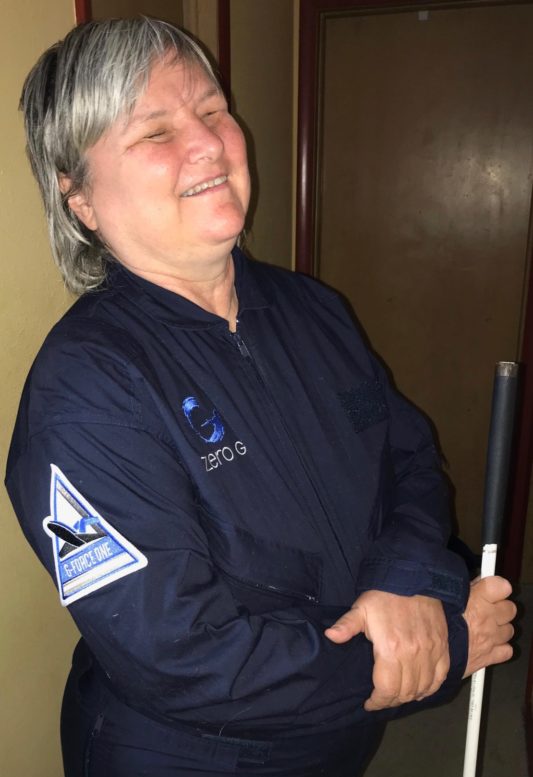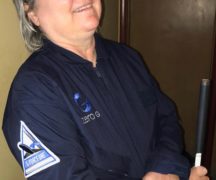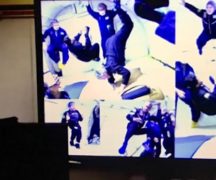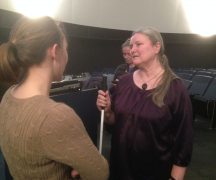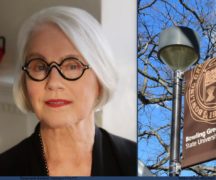By DAVID DUPONT
BG Independent News
It takes a certain kind of person to be excited about boarding something that’s called “the vomit comet.” Sheri Wells-Jensen is just that kind of person.
The BGSU linguistics professor is, among other things, an expert on xenolinguistics, the study of alien languages. and an avocational scientist.
[See BGSU scholar Sheri Wells-Jensen imagines a sightless civilization]
A week from today Wells-Jensen will climb aboard a modified 747 with a crew of fellow AstroAccess Flight 1 Ambassadors and take a Zero G Parabolic Flight over the Pacific Ocean. That flight will consist of a series of 15 steep climbs and steep descents. Depending on the downward angle, the ambassadors will experience zero gravity, or lunar or Martian gravity.
Wells-Jensen, one of the team that’s producing the flight, said she plans to faithfully take her anti-nausea medication before the flight. “That seems like a wise precaution.”
Taking a spin on the vomit comet isn’t just a lark.
The flight is the maiden voyage for Mission: AstroAccess, an organization dedicated to opening space flight to people with disabilities. The goal, Wells-Jensen said, is for a person with disabilities to eventually take a suborbital flight, and then an orbital flight.
The mission she and 11 other AstroAccess Flight 1 Ambassadors are on is meant to gather information needed to make this possible. As they are plunging they will carry out observations and experiments.
Wells-Jensen and other members of the team have been working for about a year to make the mission happen.
Its roots go back to a conversation between Anna Voelker, the director of SciAccess, and George Whitesides, former chief science officer of Virgin Galactic. Voelker suggested a zero-gravity flight for people with disabilities. Instead of dismissing it, Wells-Jensen said, Whitesides’ response was “let’s make it happen.”
Whitesides involvement is critical. “George not only really smart, but also a really kind and creative person, and guy with this ton of experience. He knows all these cool people.” There are people from the European Space Agency and former astronauts on the AstroAccess. The effort benefits from their experience, Wells-Jensen said, “because they’re all friends of George.”
Wells-Jensen became involved when she encountered Voelker at a SciAccess conference, she let them know if there anything she could contribute to “just holler.”
Voelker asked her if she wanted to join the team. Wells-Jensen agreed “after the required pause which was me suppressing my scream.”
She has been handling social media for the project. “I have been shocked and delighted by the number interesting things to do.”
Every day, she said, poses a new logistical problem that needs to be addressed. It’s all part of the meticulous planning that needs to go into the mission.
That reflects the attitude of the project.
“We don’t want to boldly go to space,” Wells-Jensen said. “We want to thoughtfully go to space.”
At this point fewer than 600 people have gone into space. “We don’t have a good lock on how best to do this. We haven’t been thinking about disability at all. We’ve been thinking about how to prevent illness and harm in space, which is good.”
Even many of the questions have yet to be formulated. So many details need to be settled “before we fling handfuls disabled people into earth orbit.”
For example, how does a blind person such as Wells-Jensen, determine where down is in zero gravity? That’s not an issue as the person is floating around in zero gravity, but once gravity comes back “you have to know how to position your body so you don’t land on your head.”
True, she said, someone could grab the blind crew member to avert injury, but that’s not an adequate solution. “The best answer is how it can be done, and not how someone can do it for you.”
For those with mobility disabilities, the issues include how to stay stationary when they can’t wrap their legs around a desk. Movement around the cabin also poses issues.
But these questions are ripe with possibility. No one has used a prosthesis in space. “We don’t know what we might want.”
Grabbing a tool that floats away is problem both for someone with mobility issues as well as someone who is blind.
On earth when Wells-Jensen drops something she can hear where it falls, and where it rolls. “And it’s just lying there waiting for me to get it.”
That’s not what happens in zero gravity. Even reaching for it can cause eddies that push it away.
The deaf ambassadors are working closing with experts from Gallaudet University on communication issues. How does sign language work if someone is upside down? And how do you get the attention of someone without hearing, for a general command?
That could be solved by a series of lights, Wells-Jensen said. Or by sound for a blind person.
This is an instance where what’s developed for space would have use in the more mundane world of commercial air travel. Wells-Jensen said she’s wondered why there’s not a beeper to tell people where the emergency exits are. Instead there are lights along the floor.
“I personally don’t like to be in a group of sighted people who are not looking where they’re going because of their eyes are on the floor,” she said.
“That’s the goal of universal design. It’s not just to kit things out so disabled people can participate” but to make everything more efficient and better for everyone.
And now is the time to work those problems out before there are space hotels, and factories, and facilities to keep GPS operating.
“The point is to learn what we need to know to make humanity’s transition into space better and safer and more inclusive.”
After the flight, the ambassadors will go through what they have learned. They’ll work with Zero G personnel on what needs to be done on the logistics for the flights. They’ll consider what demonstrations did not go as intended.
“This is the best team I’ve ever been on,” Wells-Jensen said. “Tons and tons of good will, tons of learning from each other, tons of solving problems collaboratively.”
She continued: “We really can’t wreck this. The people are so good. It’s a dream team is what it is.”
More parabolic flights are needed but “parabolic flights are not the goal. The goal is a suborbital flight followed an orbital flight with a disabled crew.”
Wells-Jensen would love to be on the orbital crew. “I’ve been dreaming of space my whole life. I’m one of those people.”
But that’s not the point, she continued. “It’s not about my personal idea of what would be fun. If we send someone on a suborbital flight, it has to be the right person,” she said. “The most important thing is the mission. We’re really changing the way humanity goes to space.”

